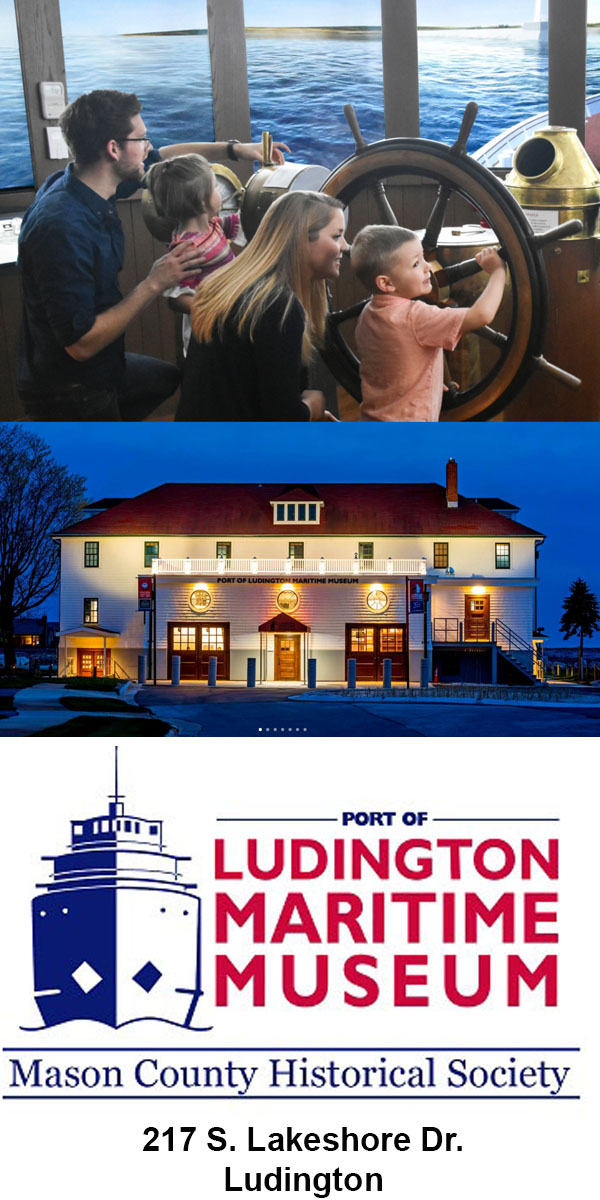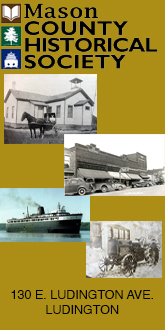
Thom Hawley speaks at the annual meeting of the Mason County Historical Society about his great-aunt, Rose Hawley.
By Rob Alway, Editor-in-Chief
LUDINGTON — During its annual meeting held Thursday, Dec. 12, 2024, the Mason County Historical Society announced that it is formally dedicating its historical collection in the memory of the organization’s matriarch, Rose Hawley. Additionally, the Society has changed the name of its downtown building, 130 E. Ludington Ave., to the Mason County Historical Society. Previously the building was known as the Mason County Research Center. The Society also unveiled two new murals that will be displayed on the building’s exterior, one honoring Hawley, the other honoring James Ludington and Eber Ward, two men who likely had the most impact on the county’s early development.
As a result, the Society has decommissioned the building at Historic White Pine Village that has been known as the Rose Hawley Museum for the past three decades. The building has not served as an active museum for several years and is in a state of disrepair. It is a pre-fabricated structure that was purchased by the Society in the mid-70s to serve as an admissions and staff housing structure. Historic White Pine Village opened as Pioneer Village on July 4, 1976.

A new mural on the front of the Mason County Historical Society building honors Rose Hawley.
During Thursday’s meeting, James Jensen, president of the Society, and Thom Hawley, the Society’s first executive director and great-nephew of Rose Hawley, spoke about Rose Hawley’s legacy.
Prior to its relocation to Historic White Pine Village in the mid-1990s, the Rose Hawley Museum had been briefly located at 115 W Loomis St., now home of the People’s Church. For the previous three decades it was located at the former Church of the Nazarene, 305 E. Filer St.
The Mason County Historical Society was organized on Nov. 30, 1937 with Pearl Darr elected as its first president. The Society initially kept its archives at the Ludington Public Library. The idea of a museum came about in the fall of 1950 when Rose Hawley (1889-1991) purchased a 1886 map of Ludington and Buttersville, Hawley took the map to the fall 1950 meeting of the Society and was named program chair. From there, she began to delve into the history of the county which led to the creation of a museum. The map is currently on display in the admissions building at the Village.
In 1951, the first historical society museum was located in the basement of the Church of Christ located at the corner of James and Court streets. Frances Caswell Hanna, who served as second president of the Society, along with Flora Clark, Myrtle Hannah, and Gertrude Hadley, arranged furniture and exhibits. Hawley was named curator.
In 1960, the Society purchased the former Church of the Nazarene for $8,500 and opened it as a museum in April 1961.

Volunteers of the year, from left, Patty Perez, and Mark and Mary Stefanik.
Hawley was also instrumental in the development of Historic White Pine Village.
“While the Historical Society was in existence prior to Rose Hawley’s involvement, she was the person who had the vision and drive to bring the collection to public,” said James Jensen, president of the MCHS. “The building at the Village that we have referred to as the Rose Hawley Museum has long been out of service in that role and no longer was a suitable dedication for someone who played such a significant role in this organization. It seemed more appropriate to dedicate the Society’s entire archival collection in her honor.”
Thom Hawley credited his great-aunt for his life-long interest in history. He said he began working at the Mason County Historical Society as an intern when he was 16. He was then hired by the Society’s board to serve as its first executive director.
In 2022, the Historical Society opened the Mason County Research Center and Mason County Emporium and Sweet Shop in the former PNC Bank building on the southwest corner of Ludington Avenue and Harrison Street. The building will now be known as the Mason County Historical Society. The Mason County Emporium and Sweet Shop, which serves as the entrance of the building, will continue with that name.
“We have discovered that the name Mason County Research Center caused some confusion with the public, many of whom thought the facility was run by the county,” said Rebecca Berringer, executive director of the MCHS. “Additionally, many people are unaware that the Mason County Historical Society owns and operates Historic White Pine Village and the Port of Ludington Maritime Museum. Changing the name of this building now establishes that this building is the headquarters of our organization and serves as the hub of our three museums.”
The Mason County Historical Society building features the majority of the Rose Hawley Archives, about 150,000 items, which include documents, photographs, newspapers, clothing, and many other artifacts that are relevant to the history of Mason County. Many more of those items can be found on display at Historic White Pine Village and the Port of Ludington Maritime Museum, which are both currently closed for the season.
The Mason County Historical Society’s downtown building is open Tuesday through Saturday from 10 a.m. to 5 p.m. Members of the Society receive access to the archives for historical research. Non-members can access the archives for a fee.
Also during its annual meeting, the Society honored some of its volunteers. John Holcomb, who has served on the Board of Directors for over 20 years, was awarded with the Rose Hawley Volunteer Legacy Award. Holcomb is retiring from the board but plans to continue as a volunteer. Also honored as volunteers of the year were Mark and Mary Stefanik for their volunteerism at Port of Ludington Maritime Museum and Patty Perez for her volunteerism at Historic White Pine Village.
Members of the Society also re-elected Jensen to the Board and elected James Nielsen and Ted May.
To learn more about the Mason County Historical Society and to join, click here.






























 (1).gif)

















.png)














